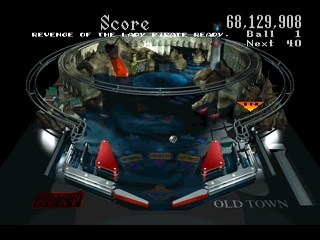I really like pinball games, both real tables and videogames. I think there's a lot to be learned about game design, especially for arcade-style games from playing them. It helps that most of them are pretty fun, even when they're not particularly well-designed because of some basic principles I'll get into later. Dragon Beat is definitely a useful learning experience, even among pinball games, as it's a masterclass in fundamentally bad design.
But first, I'll address a more obvious elephant in the room regarding this game: the way it looks. It's ugly. Very ugly. Everything is prerendered in a way that makes everything look very very dated. Some people talk about how the low polygon graphics seen on the Playstation and Saturn have aged poorly, and they're wrong in general, but Dragon Beat in particular is a game that would have benefitted greatly from having chunky polygon models with vibrant, brightly-coloured textures as opposed to the drab, wannabe realistic renders it has. The fact that prerendered backgrounds aren't exactly conducive to play and interaction is probably a mitigating factor in the game's mechanical faults, too.
Though it might just seem like flourish, an important part of what makes pinball fun is the constant stimulation. The whole time you're playing a pinball game, there's noise, flashing lights, numbers going up, stuff moving around and so on. For an example of this idea taken to its extreme, play Kaze's Digital Pinball series on Saturn (Last Gladiators and Necronomicon), games that constantly bombard the player with absurd levels of bombasticity, with guitar solos, booming proclamations and even surreal poetry recitations happening while the ball pings around the place.
Dragon Beat, by contrast is just plain old boring, in a way I've never seen a pinball game be before. More than half of your time is spent watching the ball just bounce off of walls, making no sound, scoring no points, having nothing happen. If you're lucky, you'll get the ball into a few holes , which will trigger events and let you see a little bit of cool pixel art and maybe also a glitchy pre-rendered sprite of a monster dancing around the table, but in the most part, this game is dull. (The whole theming of the game suggests that it was inspired by the work of husband and wife video pinball developers Littlewing, but only thematically. Littlewing's games are much more exciting, even their first, the primitive 1991 game Tristan, which you can play on the Internet Archive here.)
There's none of the audio-visual stimulation, none of the brain-pleasing numbers-going-up, there's nothing. Just a ball slowly rolling around an ugly table. And, in another bad aesthetic choice, the ball has some kind of weird sprite scaling thing going on, so that it shrinks when it goes up the screen, and grows when it comes down. It doesn't really work though, maybe due to the flatness of the tables themselves, and just looks strange.
Obviously, I don't recommend Dragon Beat - Legend of Pinball. Instead, you should play literally any other pinball game ever made, as I'm yet to encounter one that's anywhere near as bad as this.
Wednesday, 4 July 2018
Subscribe to:
Post Comments (Atom)






No comments:
Post a Comment